The impressionists known as Behrupiyas were more than artists in the past. They assisted in circulating, transmitting and publicising the various knowledge forms in the popular domain of Samaj, the people. The vibrant tradition of Ramlila can also be seen as an extension of this practice which continues even today. Taking a cue from the National Behrupiya Festival (IGNCA, New Delhi), Organiser brings forth a collage of this age-old Lok Parampara (tradition) and its various implications while celebrating Dussehra
A police constable in Goa, Vijay Desai stands still in a perfect pose for hours. He embodies the seriousness, aura and arresting persona of Dr Bhimrao Ramji Ambedkar. Desai delightfully says that he is doing his part in introducing the younger generation to the likes of Dr Ambedkar, Lokmanya Tilak, Shaheed-e-Azam Bhagat Singh, and others. While on the other hand, he laments that young Indians have forgetten these national icons now. He also feels sad that the tradition which he has been carrying forward is also dying slowly.
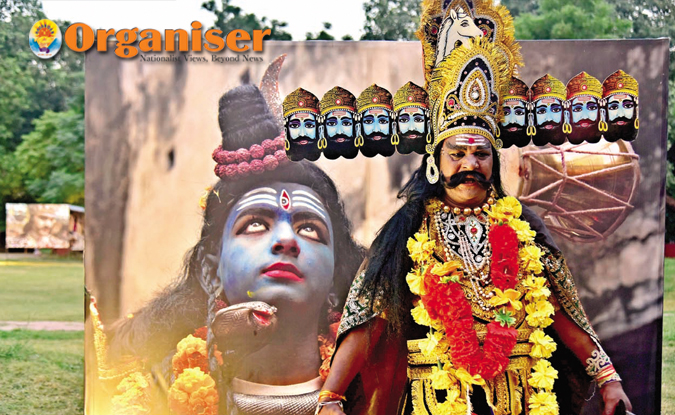
A Behrupiya impersonating Ravana during the National Behrupiya Festival held at IGNCA New Delhi
Desai is a behrupiya—an impressionist who practices a traditional art form that is several centuries old. Similar to street theatre, it is usually performed in villages. The term comes from the Sanskrit roots ‘bahu’ (meaning many) and ‘roop’ (meaning appearance or guise). They were also referred to as ‘naqal’ (the Hindi word meaning mimic) or ‘maskhara’ (a Hindustani word taken from Arabic, meaning jester or buffoon).
In the old days, behrupiyas were the main source of entertainment everywhere—from village squares to royal courts. The kings would employ them as spies, too, because they were adept at changing appearances and looks. Today, Rajasthan is home to the maximum number of behrupiyas in Bharat.
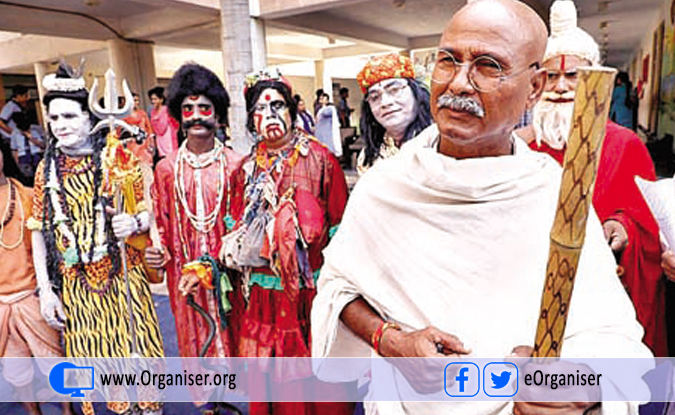
Mohanlal Bansilal extreme right impersonating Mahatma Gandhi along with other behrupiyas
Desai, along with many other behroopiyas such as Shailendra Vyas (alias Swami Muskurake), Dinesh Rawal (alias Swami Dilmilake), Bansilal Mohanlal (Mahatma Gandhi), Shamsad, and many other were the popular eye-catchers in the recently concluded National Behrupiya Festival, held at Indira Gandhi National Centre of Arts (IGNCA), New Delhi. A special attraction of this festival was 75-years old Shri Subal Bairagya from West Bengal and his son Dhaneswar who displayed different characters together like husband and wife. Three generations of one Behrupiya family from Dausa, Rajasthan namely Shri Shivraj Bhand (58) and his son Firoz (38) and Arman (15) attended this festival.
The festival witnessed behrupi artistes from various States of Bharat where this art is prevailing as a tradition. Vilas Janve (Martand Foundation, Udaipur) who helped IGNAC organise this festival told Organiser, “We say ‘Vyakti Ek Dhare roop anek’. A single artist personifies various characters.” He continued, “For the last many years I have been dealing with Behrupi artistes for various festivals like Shilpgram Utsav (Udaipur), Parampara Festival (Mumbai), Vasant Utsav (Gandhi Nagar) and Folk festivals (Goa). I have special love for this art, and I not only want to preserve this art but also develop it as an art respected by people at large.”
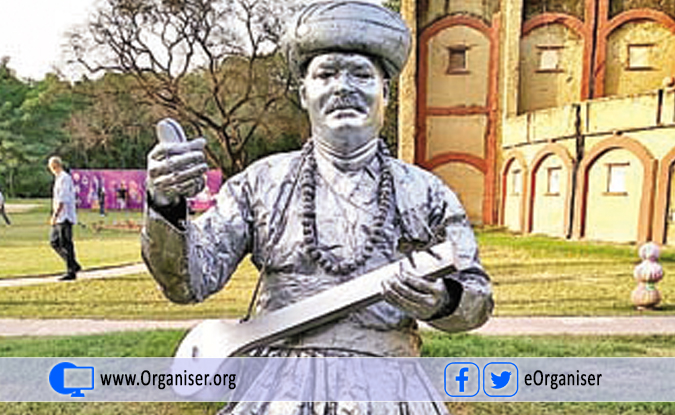
52-year old Vijay Shridhar Desai is a cop with the Goa police department
Making a Change While Keeping Mum
Vijay Desai played the shimmery Sant Tukaram, a 17th century Hindu poet and saint of the Bhakti movement. “Unlike other behrupiyas, I don’t move around or spout dialogues. I have to do something different. There are very few statue impersonators in India and none in Goa. I don’t even know any behrupiya in Goa. This is my way of standing out in the crowd,” says Desai. And stand out he does, in the way the spectators scramble over each other to pose next to his gleaming visage, holding the ektara in one hand and a symbol in the other. Desai has also impersonated Dr Ambedkar and many leaders in the form of a statue. He stands quietly for hours and attracts the viewers to the personalities he personifies.
Transmitting Knowledge
Behrupiyas, even though, have been dubbed only as impressionists; they were certainly more significant subjects in the continuity of Bharatiya civilisation. They have been the strength of Bharatiya folklore. They have acted and worked as an expressive body of culture encompassing the traditions common to all the Bharatiya culture, subculture and diverse groups. These include oral traditions such as tales, proverbs and jokes. It includes material culture, ranging from traditional building styles to handmade toys common to the group. It even takes customary lore, the forms and rituals of celebrations such as Dussehra, Diwali, Holi and regular fests in the form of Melas into account.
Shailendra Vyas from Ujjain, who is otherwise known through his performing name Swami Muskurake affirms the role of behrupiyas in the tradition of knowledge transmission. He says that “Behrupiyas played a crucial role in the popularising of the tales from our scriptures. They not only personified many personalities, but these personalities even spoke. What did they use to say?” Vyas adds, “The impressionists used to cash-in the art of story-telling to popularise their performances. If a behrupiya is playing a part of demon like Ravana, or Sri Ram, he has to deliver their lines to captivate the audiences. And in this way, Ramayana, away from the textual engagement, was made popular in the domain of the people.”
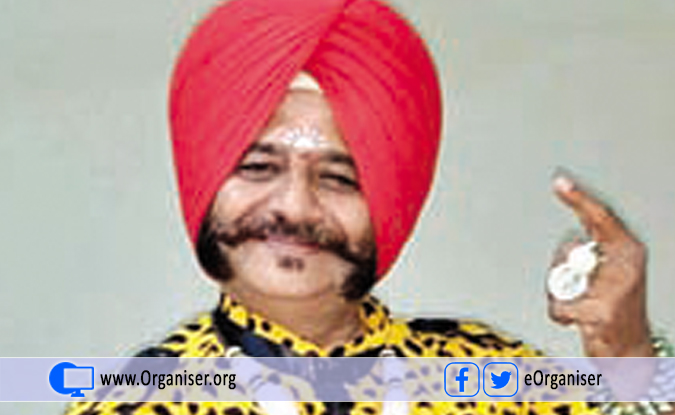
“In the ancient times, there was a personality called Vidushak who used to be spies for their Kings because of their intelligence, wisdom and mastery in disguise. Since then, to date, this tradition of behrupiyas has continued in one form or the other.”— Shailendra Vyas alias Swami Muskurake (Ujjain)
Vyas rightly points out that many who performed as behrupiyas were the same people who helped enact the Ram Leela during Dussehra all over the country. During the days of Kings and Emperors, behrupiya artists received state patronage. Due to their expertise with disguise and impersonation, good behrupiyas were recruited as spies by medieval Indian Kings.
One must contextualise the identity of this community which has a long-running in the past and continues to struggle for their survival. Abdul Hamid, another behrupiya said, “There are some two lakh behrupiyas today in the country, who are helping their livelihood with this art form. Most of them are from Rajasthan.” What is special about the Western Bharat States like Rajasthan and Maharashtra, that behrupiyas mostly belong to these States?
Perhaps the answer lies in history! A case-study of de-notified and nomadic tribes would suffice. Many communities in Western Bharat that lived on the periphery of the village-economy were, however, self-sufficient in their way. They never settled at one place and kept wandering to circulate the tales, stories, ideas, issues and material goods from one village to the other. Still today, communities like Kolhati, Nandiwale, Garudi, Makadwale, Darweshi, Bahurupi and Dawari Gosavi wander from place to place during the period of harvesting in the Western Bharat.
Now, these communities had a wandering lifestyle but it never meant that they were marginalised in the social order. On the contrary, they used to have vibrant exchanges from what we dub today or in the past as “mainstream”. Consider the following example. Banjaras consider them as Rajput race because they are scattered all over Bharat from Rajputana. The same surnames are found in Banjara which are in Rajputana today. Pawar, Rathod, Jadhav, Chavan are some of the surnames which are found in Banjara community even today.



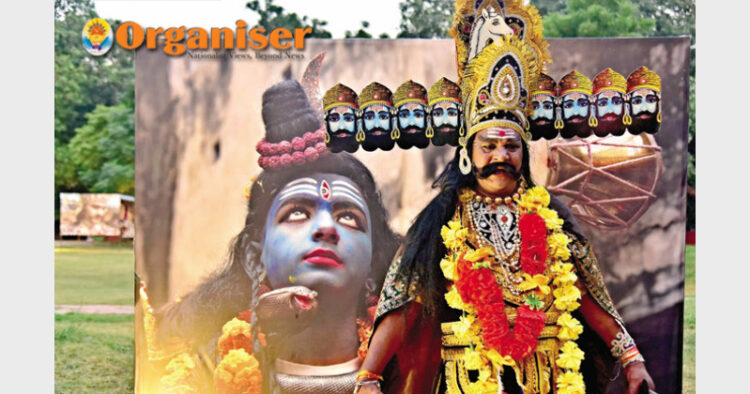










Comments